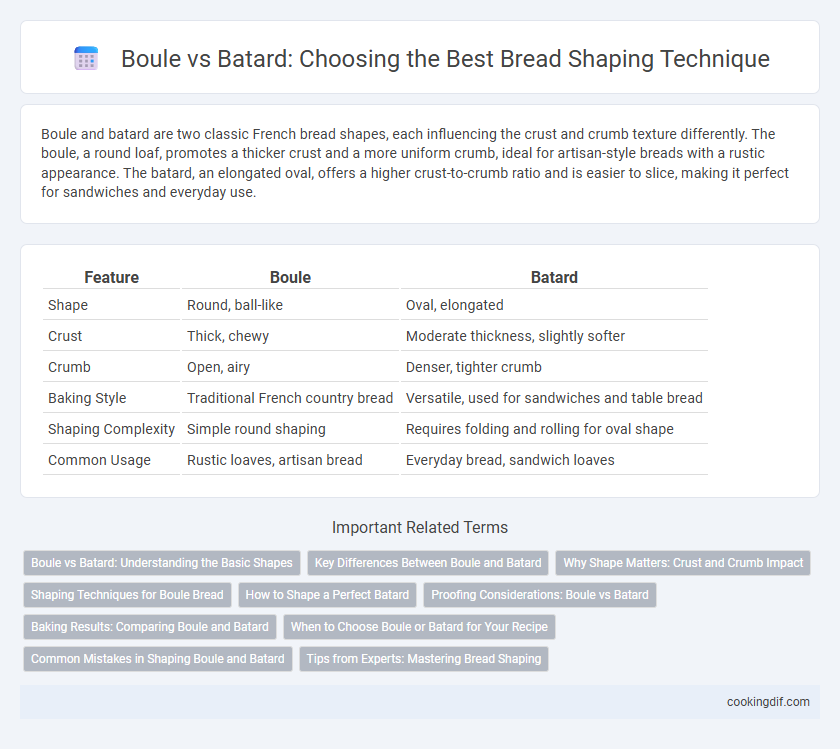Boule and batard are two classic French bread shapes, each influencing the crust and crumb texture differently. The boule, a round loaf, promotes a thicker crust and a more uniform crumb, ideal for artisan-style breads with a rustic appearance. The batard, an elongated oval, offers a higher crust-to-crumb ratio and is easier to slice, making it perfect for sandwiches and everyday use.
Table of Comparison
| Feature | Boule | Batard |
|---|---|---|
| Shape | Round, ball-like | Oval, elongated |
| Crust | Thick, chewy | Moderate thickness, slightly softer |
| Crumb | Open, airy | Denser, tighter crumb |
| Baking Style | Traditional French country bread | Versatile, used for sandwiches and table bread |
| Shaping Complexity | Simple round shaping | Requires folding and rolling for oval shape |
| Common Usage | Rustic loaves, artisan bread | Everyday bread, sandwich loaves |
Boule vs Batard: Understanding the Basic Shapes
Boule and batard represent two fundamental bread shapes, each influencing the loaf's texture and crust. The boule is a round, ball-shaped loaf that promotes a thick crust and chewy interior due to its compact form. In contrast, the batard is an oval or oblong shape that bakes more evenly, offering a balanced crust-to-crumb ratio ideal for slicing and sandwiches.
Key Differences Between Boule and Batard
Boule and batard differ primarily in shape and texture, with boule presenting as a round, ball-shaped loaf and batard as an elongated oval. The boule's thicker crust and denser crumb contrast with the batard's thinner crust and lighter interior, making each suitable for different culinary uses. These distinctions influence baking times and crust development, with boule requiring longer baking due to its shape and denser structure.
Why Shape Matters: Crust and Crumb Impact
The boule's round shape promotes even heat distribution, resulting in a thicker, crispier crust and a denser crumb structure ideal for hearty artisanal loaves. In contrast, the batard's elongated form allows for more surface area contact with heat, producing a thinner crust and a lighter, airier crumb suitable for sandwich breads. Shape impacts baking dynamics, directly influencing the texture and flavor profile of the final loaf.
Shaping Techniques for Boule Bread
Boule bread is shaped into a round, ball-like form by gently folding the dough inward from the edges toward the center, creating surface tension that helps retain its structure during baking. This shaping technique involves cupping the dough in the hands and rotating it on a work surface to tighten the outer skin, promoting an even rise and a uniform crumb. Proper boule shaping ensures a crisp crust and a soft, airy interior, characteristic of traditional French country bread.
How to Shape a Perfect Batard
To shape a perfect batard, start by flattening the dough into a rectangle, then fold the short edges toward the center, creating a tight seam; this technique helps develop structure and an even crumb. Roll the dough gently from top to bottom, maintaining consistent pressure to form an elongated oval shape with tapered ends characteristic of a batard. Proper shaping ensures optimal oven spring and a crust that is both crisp and evenly browned, differentiating it from the round boule.
Proofing Considerations: Boule vs Batard
Boule and batard differ significantly in proofing due to their shapes; the boule's round form promotes even fermentation and consistent gas retention, resulting in a uniform crumb structure. The batard's elongated shape requires careful handling during proofing to prevent uneven expansion and potential collapse, as its surface area exposes it more to air, potentially accelerating drying. Understanding these proofing nuances ensures optimal texture and rise, enhancing the final quality of artisanal bread.
Baking Results: Comparing Boule and Batard
Boule produces a round, evenly baked crust with a chewy texture due to its compact shape, which retains moisture effectively during baking. Batard's elongated form allows for a crisper, thinner crust and a more open crumb structure, ideal for artisan-style loaves. Both shapes influence oven spring and crumb density, with boule favoring uniform crumb development and batard offering varied textures within the bread.
When to Choose Boule or Batard for Your Recipe
Boule and batard are French bread shapes that affect crust texture and crumb structure, influencing their ideal recipe applications. Choose boule when aiming for a round, rustic loaf with a thick crust and open crumb, perfect for hearty, artisan-style breads. Opt for batard to achieve an elongated loaf with a thinner crust and tighter crumb, ideal for sandwiches or recipes requiring even slicing.
Common Mistakes in Shaping Boule and Batard
Common mistakes in shaping boule and batard include improper tension during dough folding, leading to uneven crumb structure and misshapen loaves. Many bakers struggle with inconsistent shaping pressure, which causes the boule to lose its signature round domed form and the batard to develop an irregular oval shape. Ensuring even dough surface tension and symmetrical folding techniques prevents common issues like flat tops or sagging sides in both bread shapes.
Tips from Experts: Mastering Bread Shaping
Mastering bread shaping requires understanding the key differences between boule and batard forms: boule is a round, tight, rustic loaf ideal for even crumb and crust, while batard is oval-shaped, offering increased surface area for crust development. Experts emphasize proper tension during shaping to create a uniform crumb and prevent dough slack, recommending gentle but firm folding techniques to maintain the dough's gas retention. Using bench flour strategically and allowing adequate resting periods between folds enhances elasticity and helps achieve the desired boule or batard structure, ensuring artisanal quality in every loaf.
Boule vs batard for bread shaping Infographic

 cookingdif.com
cookingdif.com